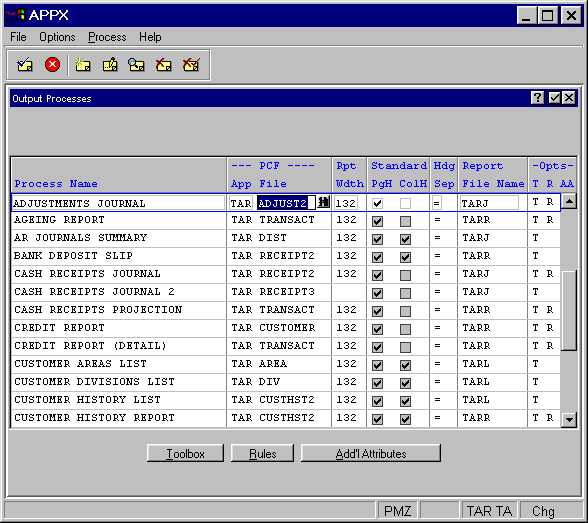


Output Process Specifications
Output process specifications establish the general attributes of an output process such as a process print file and process control file, the name of the report, and various format characteristics.

Figure 3-7-2. Output Processes Screen
The Output Processes screen, shown in Figure 3-7-2, contains the following fields.
· Process Name identifies a specific process and consists of 30 uppercase alphanumeric characters that must be unique within type and application.
· App/PCF Name identifies a file by application ID and file name that is to be automatically managed by APPX during the execution of this process. The process control file (PCF) is the only file APPX automatically reads, writes, rewrites, and deletes records for during process execution.
· Rpt Wdth indicates the maximum number of characters across, or in other words the number of columns, to allocate for each row in the report format. APPX uses the value you enter here to produce standard images of the proper width. If blank, the default width of the form that the report prints on defaults to the form width which is defined in system administration. If the form is narrower than the width of the formatted report, APPX truncates the output. If the form is wider than the width of the report, however, APPX uses the larger width for standard images, but does not expand the format of the report itself. The default is 132.
·
Standard PgH determines whether or not APPX automatically prints a page heading standard
image. If “yes” ![]() ,
this image prints before any Start of Page frames for the report. Be careful not to also explicitly
define a Start of Page frame with a page heading standard image, which could cause the standard
image to print twice at the top of each page in the report. If “no”
,
this image prints before any Start of Page frames for the report. Be careful not to also explicitly
define a Start of Page frame with a page heading standard image, which could cause the standard
image to print twice at the top of each page in the report. If “no” ![]() ,
you can explicitly define a Start of Page frame with a page heading standard image or, alternatively,
define your own page heading using a Start of Page frame. The default is “yes”.
,
you can explicitly define a Start of Page frame with a page heading standard image or, alternatively,
define your own page heading using a Start of Page frame. The default is “yes”.
·
Standard ColH determines whether or not APPX automatically prints a Start of Page
frame with a column heading standard image. APPX generates column headings based upon specifications in
the data dictionary for each item included in the output image. If “yes” ![]() ,
this image prints after any Start of Page frames for the report. Be careful not to also explicitly
define a Start of Page frame with a column heading standard image, which would cause the standard
image to print twice for each page in the report. If “no”
,
this image prints after any Start of Page frames for the report. Be careful not to also explicitly
define a Start of Page frame with a column heading standard image, which would cause the standard
image to print twice for each page in the report. If “no” ![]() ,
you can explicitly define a Start of Page frame with a column heading standard image or, alternatively,
define your own column headings using a Start of Page frame. The default is “yes”. Refer
to Standard
Column Heading Image for additional information.
,
you can explicitly define a Start of Page frame with a column heading standard image or, alternatively,
define your own column headings using a Start of Page frame. The default is “yes”. Refer
to Standard
Column Heading Image for additional information.
· Hdg Sep identifies one alphanumeric character that prints continuously across the report to separate standard page headings, page frames, and standard column headings from the body of the report. If blank, APPX does not print a heading separator. The default is =.
· Report File Name establishes the name of the file that is used to store the contents of the printed report. If necessary to guarantee uniqueness, APPX may append one or more characters to the value you enter here, or replace one or more of the ending characters. If two or more output processes in the same subprocess family are defined with identical Print File values, the processes share a common print file. They print as a single report, with continuous page numbers. If this specification is blank, APPX uses the last Print File that is active within the subprocess family. Refer to Process Lineage for a definition of subprocess family.
· Opts are indicators that are present whenever documentation (T), rules (R), or additional attributes (AA) have been defined for this process.
The Output Processes screen contains the following options as described in the corresponding sections:
· Toolbox
· Rules
APPX Application
Design Manual (01/13/03)



© 2003 by APPX Software, Inc. All rights reserved